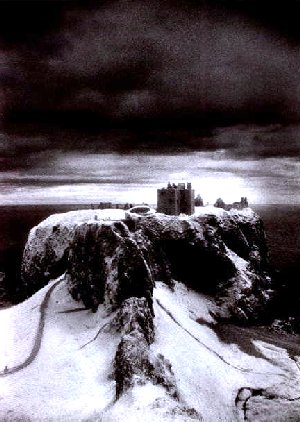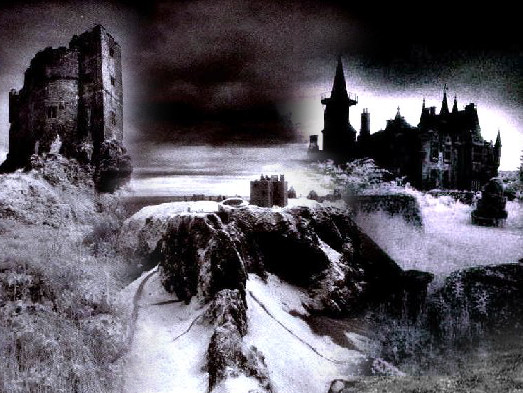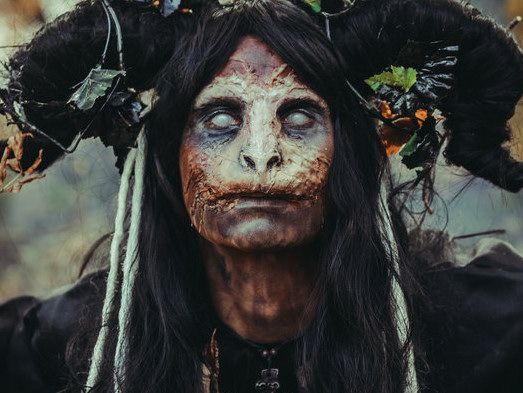Scotland has often been called one of the most haunted countries on Earth, and it’s little wonder as Scotland had a savage history that was filled with bloodshed. Tales of murder, war, disease and downright cruelty often lies behind these ghostly sightings in some of the country’s most famous castles, thoroughfares, and tourist attractions.
DUNNOTTAR CASTLE
 Dunnottar Castle in Kincardineshire, one of the most notorious places in Scotland, sits high upon a sandstone cliff overlooking the North Sea. The castle is seemingly invincible, impenetrable; however, the castle, covering four acres, has been successfully sieged many times between the ninth and seventeenth century, and it’s long and bloody history, goes back even further. Unsurprisingly, it’s said that the castle’s many ghostly residents still haunt the place. Their cries can be heard coming from the cliffs at night, and the spectral images can be seen in the dark, lofty halls. Historian Beattie of Caledonia said, “To him who is familiar with history, Dunnottar speaks with an audible voice. Every cave has a record, every turret has a tongue.”
Dunnottar Castle in Kincardineshire, one of the most notorious places in Scotland, sits high upon a sandstone cliff overlooking the North Sea. The castle is seemingly invincible, impenetrable; however, the castle, covering four acres, has been successfully sieged many times between the ninth and seventeenth century, and it’s long and bloody history, goes back even further. Unsurprisingly, it’s said that the castle’s many ghostly residents still haunt the place. Their cries can be heard coming from the cliffs at night, and the spectral images can be seen in the dark, lofty halls. Historian Beattie of Caledonia said, “To him who is familiar with history, Dunnottar speaks with an audible voice. Every cave has a record, every turret has a tongue.”
One of the earliest accounts of violence arrived via the ancient Picts who held a prehistoric fort on this same rock. Many bloody skirmishes darkened the atmosphere during the time they controlled the area. One would have hoped that the violence would end when, in the fifth century, St. Ninian built a church within its grounds. But it wasn’t to be. A siege in 681 is recorded in the Annals of Ulster, and in 900, the castle fell and was taken from King Donald II by the Vikings. It’s also recorded that in 934, the King Aethelstan of Wessex, “wasted Scotland with a land army as far as Dunnottar.”
Amazingly, the site was again used for religious purposes in 1276, when the Bishop of St. Andrews built another church. Soon, the population in the area grew, and the castle became more like a small village, having a barracks, a chapel, stables, a priest’s house, and even a graveyard.
The violence that had shrouded the castle and the surrounding hunk of land since prehistoric times, had only just begun.
In 1297, William Wallace’s Scottish army sieged and destroyed the castle and its occupants. Actually Wallace burned the English Plantagenet residents alive when they sought refuge in the church.
The English would take the castle again in 1336. As a result, King Edward III visited the dire abode that year. But not long afterward, the Scottish Regent, Sir Andrew Moray, retook the castle and burned it.
Sir William Keith, Great Marischal of Scotland, rebuilt the castle in 1531. His family held the property for three centuries, but that didn’t end the violence and the bloodshed.
Dunnottar was also the scene of the infamous witch hysteria that festered through Europe at the time. Several witches, who were apprehended in Aberdeen, were taken to Dunnottar and burned at the stake on the castle grounds in 1595. One can only fathom what kind of torture they and others endured within the grim dungeon walls.
Likely, many witch executions at the castle were never recorded, but Dunnottar would be the scene of many more bloody battles as well.
When the Royalist Army was close to being completely defeated in 1651, many of the Scottish crown jewels, including the royal scepter were hidden within the castle as Dunnottar was thought to be one of the strongest and safest locations in Scotland. When Oliver Cromwell’s army advanced and sieged the castle on an eight month campaign, Royalist occupants knew they had to smuggle the treasure to safety.
No one knows for sure how this was accomplished. But it’s thought that the treasure was lowered down the side of the cliff late at night and that a servant girl, possibly Anne Linday of Edzell, hid it beneath her skirt. Supposedly, she then buried the jewels in the floor of a nearby church. Some believe that some of the jewels are still hidden somewhere near the castle, but no one knows the precise spot. Perhaps the ghosts know, but they are unlikely to give up their secrets.
Of the numerous ghosts in the castle, many were doubtlessly innocent civilians, victims who were persecuted solely for political reasons.
In 1685, anti-Royalist Covenanters and their families were imprisoned in the castle’s dank bowels. No fewer than one hundred and sixty, men, women, and children were tortured brutally for their religious beliefs and were feed rotten meat, raw fish, and seawater. These poor souls died terrible deaths from cold and starvation. In desperation, some tried to escape down the sheer cliff, which was one hundred and sixty feet above the sea, in the darkness of the night only to become the victims of the unyielding landscape. The dark cellar, known as the “Whig’s Vault,” can still be toured today, and it supposedly looks exactly like it did during this reign of horror.
The entrance to the castle is through a long path that leads to the gatehouse, however, there’s also a secret entrance via a tunnel with steps in the cliff. Near the secret entrance, the ghostly image of a man is often seen who appears to be staring out at the sea and watching or waiting for something. He appears to be a soldier from an earlier time, dressed in the military regalia from an early period in Scottish history. Many have reported that he’s tall and dark.
After the rebellion of 1715, the castle and surrounding buildings fell into disrepair. In 1925, the first Viscountess Cowdry began a restoration program. The castle is now maintained by the Dunecht Estates and is open for tourism.
Recently, Dunnottar castle was used in the Hamlet film, starring Mel Gibson.
ECCLESCRIEG HOUSE
 Ecclescrieg House, in St. Cyrus, Aberdeenshire is another spooky place. Bram Stoker used to spend his holidays at nearby Cruden Bay, and it’s said that he used the old house as inspiration for Count Dracula’s castle. Looking at the photo, it’s little wonder that it sparked his creativity.
Ecclescrieg House, in St. Cyrus, Aberdeenshire is another spooky place. Bram Stoker used to spend his holidays at nearby Cruden Bay, and it’s said that he used the old house as inspiration for Count Dracula’s castle. Looking at the photo, it’s little wonder that it sparked his creativity.
It’s said that it’s haunted due to a curse placed on the original owners, the Forsyth-Grant family.
The nightmare started when Osbert Clare Forsyth-Grant, 1880-1911, joined the Navy against his father’s wishes. Supposedly, he sailed from Montrose to command a whaling ship whose crew was composed of Scots and Eskimos. Something happened between Osbert and the Eskimos…no one knows what, but it must have been quite a travesty as they put a curse on him and his family. Not long afterward, his ship, the Seduisante wrecked in a storm and went missing. A mutiny ensued on board the ill-fated vessel, but no one knows the details with any certainty, because only a few Eskimos lived to tell about the incident.
Grant’s body was never recovered. It’s said that his father never quite recovered from the incident and continually stood on the terrace, staring at the sea through some binoculars, never losing hope that his son would return. The old man is still seen walking the grounds, waiting for a son who will never return.
ROCHE CASTLE
Roche Castle, in Pembrokeshire, is purported to be another haunted castle. It has been associated with supernatural happenings since the 13th Century. It’s said that a witch told the owner, Adam de la Roche, that an adder would bite and kill him. Terrified of the premonition, Roche built the castle high upon a rock bereft of moorland or undergrowth to attract the creatures. Yet, even safely hidden in his mighty fortress, Roche remained horrified of the prophecy and became a recluse behind the thick walls.
Amazingly, a snake did manage to find it’s way into Roche castle.
On a cold winter night, a servant had carried in a bundle of twigs for the great hall fire. An adder emerged from the wood pile late that night to bite the sleeping nobleman on the leg.
The next morning, Roche was discovered dead.
 Roch castle is also said to be haunted by the ghost of Lucy Walters, the mistress of King Charles the II. Lucy, who was supposedly a beautiful woman, met the King in Holland when she was on vacation with her lover, Colonel Robert Sydney. She and Charles instantly felt some chemistry for each other, and, soon she became the mother of Charles’ son, the Duke of Monmouth. Unfortunately, the King tired of Lucy. Though he put his favorite bastard son under the care of his wife, sadly, he spurred Lucy. As a result, she died from poverty at only twenty-eight-years old.
Roch castle is also said to be haunted by the ghost of Lucy Walters, the mistress of King Charles the II. Lucy, who was supposedly a beautiful woman, met the King in Holland when she was on vacation with her lover, Colonel Robert Sydney. She and Charles instantly felt some chemistry for each other, and, soon she became the mother of Charles’ son, the Duke of Monmouth. Unfortunately, the King tired of Lucy. Though he put his favorite bastard son under the care of his wife, sadly, he spurred Lucy. As a result, she died from poverty at only twenty-eight-years old.
Her ghost, cloaked in white, is said to walk about Roch castle, even floating through shut and locked doors. In the wee hours of the night, she reportedly often awakens sleepers.
© Bobette Bryan, 1998-2024



